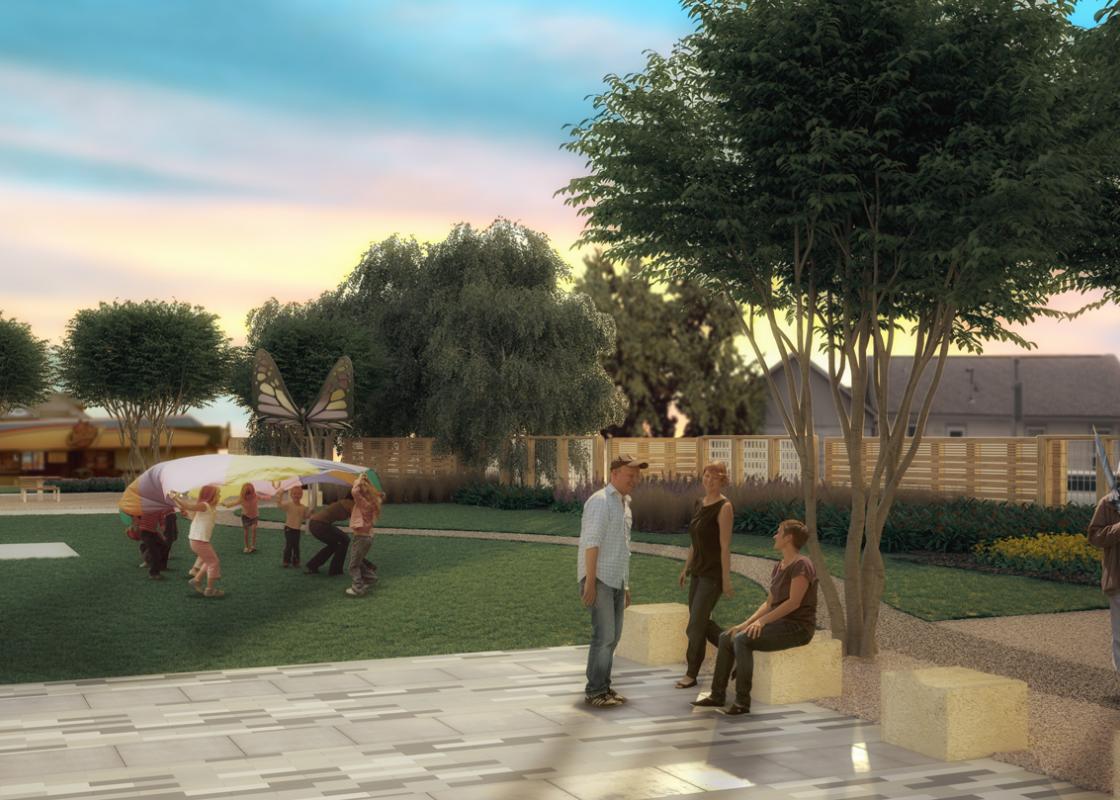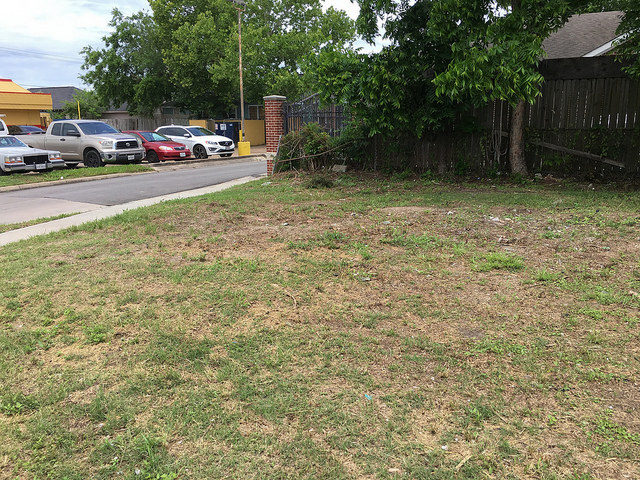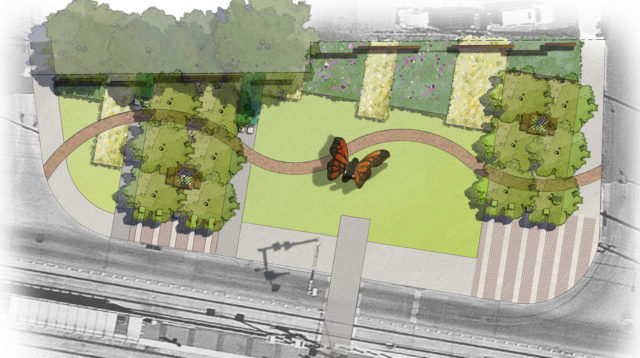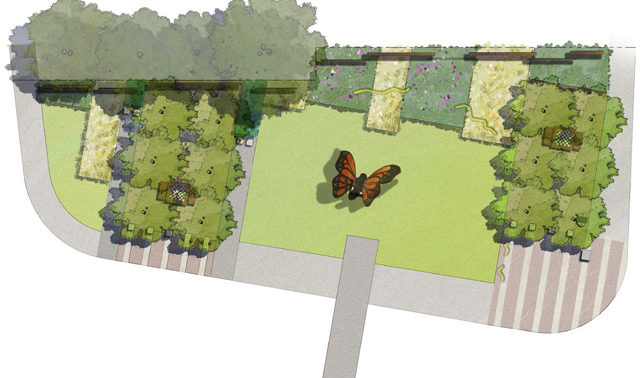Not all vacant lots are the same. Some are nestled between residential lots and looked after by neighbors; some are littered and adjacent to highways; still others have a nascent appeal that can benefit from the right intervention.
One such lot is located along Fulton Street between Panama Street and Hammock Street in the Near Northside. The property consists of two vacant lots owned by the City of Houston’s Parks and Recreation Department. A crosswalk connects the property to a light rail stop. There are commercial properties along Fulton to the north, south, and west; to the east is a residential area. Currently, there is one tree in the middle of the site, overgrown brambles and a row of trees along the fence on the eastern side of the property, and a utility right-of-way with power lines that bisect the lot.
Community members have long wanted to create a pocket park here. Recently, they worked with the Greater Northside Management District (GNMD) to realize that vision.
Rose Toro, a local artist who has done numerous installations in public spaces in Houston and other cities, got involved. She developed a concept for a butterfly garden to accompany a large butterfly sculpture that she will create. She then worked with the GNMD and Avenue CDC to secure grant funding for the initial phase of project.
The GNMD needed more community input and a way to turn this concept into architectural drawings. They reached out to us at Open Architecture Houston (OAH), a local nonprofit that connects underserved communities with design professionals, to help facilitate the design and community engagement process.
First, we hosted a community design charrette with the help of partners Avenue CDC and GNMD, which included community members and volunteer design professionals. There, we presented the project scope and criteria specified by the community. GNMD had some additional criteria as well, as they will be responsible for maintenance of the park. There were to be no water features and no benches, but the community members wanted shade, bike racks, irrigation for plants, lighting, and signage. Community members and designers then formed groups and sat down together with maps, tracing paper, and markers to begin brainstorming possible uses for the lot --- envisioning all the ways they could activate the lot and enhance their community. At the end of the evening, each group presented its ideas and shared its excitement about the project.
Once all the sketches were compiled and ideas catalogued, the design work began. We had a follow-up meeting after the charrette where we divided the designers and community members into two teams to pursue two different concepts that emerged at the charrette. DeMera Ollinger led a team that included Allison Pate, Ishraq Aljassar, Tuyet Huynh, and community member Edward Carranco. Jaime Pujol led another team that included Lauren Norton, Blake Coleman, Katherine Gullick, and community members Lionardo Matamores and Mat Wolff.
The teams had three weeks to work on the designs before presenting them at a public meeting back in the Near Northside. They met on their own to visit the site and refine the designs. The designers worked after regular hours to complete the design concepts, create renderings to communicate their ideas to a lay audience, and compile presentations with site analysis and design elements. The OAH team met internally near the end of those three weeks so that the two teams could present to each other and strengthen each other’s designs. A representative from CenterPoint attended that meeting to clarify the process of moving the utility pole and wires out of the future pocket park. Finally, the designers met with Toro to make sure her sculpture was coordinated with their designs.
OAH then facilitated a second community meeting where the teams presented their designs. Team 1 created a design based on elements associated with a caterpillar’s life cycle. Where they saw pedestrians cutting through the lot they designed diagonal paths. They created buffer plantings along the back of the lot to soften the back fence and screen the view of the neighbors. Toro's butterfly sculpture is at the intersection of the paths, and a plaza on the corner provides seating and a colorful painted pattern mimicking a Monarch caterpillar. Additional design elements they suggested included using colorful yarns to knit around the trunks of the trees and hanging hammocks for relaxing.
Team 2 used the geometry of the rail tracks and crosswalk to inform its rectilinear patterns in the design. Two copses on the north and south end of the park provide shade in plazas with chess boards and cubes for seats. Toro's butterfly sculpture is in the center of the lawn, adjacent to a meandering path that winds from the north to the south side of the park. Planting beds and a fence screen the view of the neighbors to the east. The beds also maintain the rectilinear design concept and alternate between butterfly gardens and edible gardens.
Both teams presented their design concepts to the community members at the meeting. Here, community members were invited to ask questions. Questionnaires solicited further feedback on the designs and the community members’ like or dislike of specific features.
The designers then had 10 days to integrate the feedback, create a phasing plan, and outline a budget for the project. Because of the short timeline, which was tied to Avenue CDC’s grant deadline for the project, it was impossible to combine elements from the two designs; instead, one design was chosen and refined. The final design is a variation on the original design by Team 2. The meandering path has been removed and a sculptural element has been added. Sculptural piping in bright colors will be used near the street in the southwest plaza as bike racks; larger versions will wind through the garden beds and ultimately be used to help support the butterfly sculpture. Part of the community feedback from the initial design presentation was to find a way to honor Josue Flores in the park. Community members would like to name the park after him or create a memorial of some kind. The designers think that the north side of the park, which is separated from the butterfly sculpture and main lawn, would be a quiet space ideal for a memorial. The discussion about how exactly the community wants to honor Flores will be brought up at the final design presentation.
Next steps for the pocket park include a partner meeting where OAH and the designers will go through the phasing plan and budget with GNMD, Avenue CDC, the Parks Department, and Representative Karla Cisneros. Designers will present the final design and phasing plan at the beginning of a Super Neighborhood Meeting at the Leonel Castillo Community Center, 2101 South Street, on July 21 from 6 p.m. to 6:30 p.m.
By Kate Cairoli, MA, LEED, Director of Communications for Open Architecture Houston














